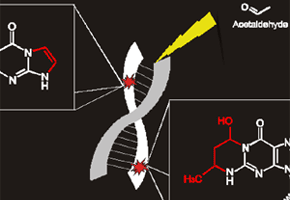

The objective of this study is to use compounds as biological markers to evaluate the risk of cancer and the exposure to urban pollution.
The objective of this study is to use compounds as biological markers to evaluate the risk of cancer and the exposure to urban pollution.
The objective of this study is to use compounds as biological markers to evaluate the risk of cancer and the exposure to urban pollution.

The objective of this study is to use compounds as biological markers to evaluate the risk of cancer and the exposure to urban pollution.
By Elton Alisson
Agência FAPESP – Many chemical agents, such as the aldehydes present in cigarette smoke and in urban and industrial pollutants, produce a series of compounds in human cells known as adducts that are capable of inducing mutations in DNA, which could in turn lead to the development of cancer.
To detect and quantify elevated levels of adducts associated with many types of cancer, researchers at the Universidade de São Paulo’s Chemistry Institute (IQ/USP) are using ultrasensitive techniques including mass spectrometry.
Some of the results of the FAPESP-funded Thematic Project were presented at the 4th BrMASS Congress, held by the Brazilian Mass Spectrometry Society in Campinas, SP, in December.
According to Marisa Helena Gennari de Medeiros, IQ professor and coordinator of the project, her research group has managed to detect and quantify adducts produced by aldehydes (ethylene adducts) in human cells, both in culture and in liver, brain and lung tissue from rats exposed to pollution.
“Of the techniques that have been used, mass spectrometry is currently the most important and efficient in detecting and quantifying adducts in DNA,” she said.
The researchers are aiming to use these adducts as biological markers (biomarkers) in clinical settings to determine the risk of developing cancer or to evaluate the level of exposure to different urban and industrial pollutants.
With these biomarkers, in a city like São Paulo, where the population is exposed to many different pollutants, it would be possible to determine which of these pollutants is specifically responsible for certain adducts in the DNA. “We would then have specific proof that a certain pollutant really affects human health,” said Medeiros.
Using mass spectrometry together with isotopic labeling—a process by which a substance is “labeled” by the inclusion of a rare isotope in the chemical structure of the compound—the researchers demonstrated the formation of an adduct derived from acetaldehyde.
The study showed that the compound produced from burning wood and cigarette tobacco, among other sources, can be a biological marker for both exposure to urban pollution and alcoholism, which is one of the main factors that causes mouth, throat and pharynx cancer.
Adduct quantification
Some of the results of the study were published in the Journal of The American Chemical Society and may be used to explain the mechanisms associated with exposure to the chemical compound and cancer risk.
“We shed light on the formation of this adduct from acetaldehyde, a genotoxic environmental product, which was quite a controversial topic. The product formed is a demonstrably mutagenic DNA adduct also produced by the metabolic oxidation of ethyl alcohol,” said Medeiros.
According to Medeiros, interest in research on ethylene adducts began in recent decades when a number of very rare primary liver cancer cases (hepatocellular carcinoma) appeared among workers in a plastics factory in the United States.
In their investigation regarding the origin of the disease, specialists determined that the disease was due to the exposure of the workers to carcinogenic compounds such as vinyl chloride and urethane (ethyl carbamate), both of which are used in the fabrication of polymers.
In 1992, scientists were able to determine the number of ethylene adducts produced by vinyl chloride in liver, lung and kidney tissues in rats and in workers in the North American plastics industry who had been exposed to the compound. From then on, there has been a search for ultrasensitive techniques that are able to identify and quantify these adducts in vivo.
“These adducts promote the transition and substitution of DNA base pairs. There are already some known systems for repairing them in mammal and rat cell extracts,” said Medeiros.
Medeiros is currently coordinating another FAPESP-funded Thematic Project.
The article [13C2] - Acetaldehyde Promotes Unequivocal Formation of 1,N2-Propano-2′-deoxyguanosine in Human Cells (doi: 10.1021/ja2004686) by Medeiros and others can be read by subscribers of the Journal of The American Chemical Society at http://pubs.acs.org/doi/abs/10.1021/ja2004686.
Republish
The Agency FAPESP licenses news via Creative Commons (CC-BY-NC-ND) so that they can be republished free of charge and in a simple way by other digital or printed vehicles. Agência FAPESP must be credited as the source of the content being republished and the name of the reporter (if any) must be attributed. Using the HMTL button below allows compliance with these rules, detailed in Digital Republishing Policy FAPESP.





